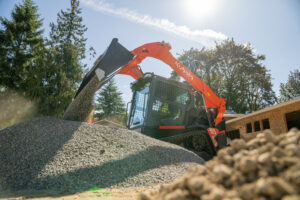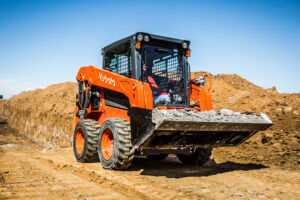
Compact track loader or skid steer?
By Jonathan Gardner
Construction EquipmentChoosing the right piece of equipment for your jobsite.
When it comes to the jobsite, there is no replacement for a machine that can do the heavy lifting while providing power, performance and versatility in a compact package. Visit any construction site and you’ll likely see a skid steer or compact track loader hard at work, making these machines “must-haves” for contractors. It’s not a question about “if” you need one of these pieces of equipment on the jobsite; it’s simply a matter of choosing the right one. Choosing between track or tires often comes down to where the machine will be used.
Before compact track loaders started showing up on construction sites in the mid-1980s, skid steers reigned supreme and were often a staple for many operators. This is no surprise given the machine’s perfect combination of agility and power, expanding the work and places of operation significantly. However, once track loaders started showing up, these quickly became popular, and operators began making the switch. According to industry sales reports, sales of compact track loaders surpassed skid steers for the first time in 2015.
There’s no doubt that compact track loaders are dominating the market, mainly due to their rubber tracks and their ability to navigate jobsites with extra flotation, especially in the wet weather months. Additionally, a dedicated undercarriage provides added power while dispersing the weight of the entire machine through multiple track contact points for less ground pressure, a greater lifting force on soft surfaces and, most importantly, the ability to continue working — no operator wants down time or delays.
These benefits aside, both pieces of equipment have their place on jobsites. Before determining which one is right for your project, consideration should be placed on assessing the conditions of the jobsite and the specific tasks you intend to accomplish.
Here are three key questions to ask yourself when selecting your machine:
1. What are the jobsite surfaces and terrain?
Are you working on asphalt, concrete or other hard or abrasive surfaces? If so, skid steers’ tires tend to be better suited for these surfaces as they minimize damage and provide the operator with a comfortable ride. It is also important to choose the correct tire and wheel for your application, including off-road, all terrain, turf, smooth and the choice of tweel or solid wheels.
On the other hand, compact track loaders excel on soft soils like mud, sand or snow due to flotation. Furthermore, maneuverability is increased with the track, making for great performance in inclement weather. The compact track loader is also gentler on soil, sand and gravel but can struggle when it comes to operating on concrete or hard ground. Driving on this terrain can often damage the tracks and leave marks on asphalt and concrete.
2. Is speed and ground disturbance a consideration?
Are you working on a big construction site where speed is an advantage? Or do you require a tight turning radius? If you answered yes to these questions, then a skid steer has the upper hand. In general, skid steers have a faster travel speed. If you are travelling long distances, it is important to consider options such as Ride Control and air ride seat. Ride Control will turn the loader arms into shock absorbers, preventing the loss of material when travelling over rough terrain.
However, if you’re working on a surface where you need to minimize ground disturbance, such as on turf, the compact track loader is the better choice due to the even distribution of weight and ground pressure. Tracks also have an advantage in wet conditions because of flotation, whereas skid steers tend to get stuck in these situations.
3. What is your budget and ability to maintain the equipment?
Skid steers are typically more affordable than compact track loaders. It is often less expensive to replace the tires on a skid steer than it is to replace the rubber tracks on the track loader; however, this is impacted by the maintenance and care that the unit receives. To improve the longevity of your tracks it is important to continue to check the track tension.
Working conditions also play a key role in maintenance and budget. It is recommended to work under the conditions that the manufacturer deems as normal. Working in harsh environments increases the need for maintenance which can also impact the cost of ownership.
What’s good for you, and your jobsite
Whether you’ve determined that a skid steer is the right piece of equipment for your jobsite, or compact track loader is the machine for you, the good news is that you can’t really go wrong with either. Skid steers and compact track loaders increase productivity and operations across all jobsites and are popular with many operators for their speed, maneuverability, compact size, power, attachment options, and more.
When choosing a skid steer or compact track loader, it is important to consider where it will be used and the terrain it is intended to operate, whether you are looking for speed or for limited ground disturbance, and how much you are looking to invest in the piece of equipment itself. These considerations will impact and help you make the right decision between a skid steer or compact track loader.
Jonathan Gardner is the construction equipment product manager at Kubota Canada.






